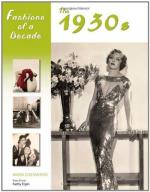|
This section contains 222 words (approx. 1 page at 300 words per page) |

|
American fashions shifted in the 1930s. The 1920s had been a decade of excess. Fashions for both young men and women—the "sheiks" and "flappers"—grew increasingly extravagant. The Great Depression (1929–41) discouraged unnecessary spending on fashion. Americans tried to get by with what clothes they already had, make do with what clothes they could afford, or do without certain garments entirely.
Extravagant fashions for different seasons were no longer affordable to many. Instead, practical clothing that could be worn in many different seasons and for many different occasions filled retail shops. Since most American women could not afford original French fashions, American designers soon created simpler copies of French designs in a variety of price ranges. The most popular dress for women was a simple short-sleeved print dress with a belted waist and a flowing calf-length skirt. Expensive fabrics like silk were replaced by...
|
This section contains 222 words (approx. 1 page at 300 words per page) |

|



